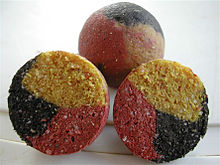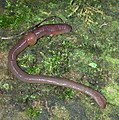Fishing bait



Fishing bait is any
Fishing baits can be grouped into two broad categories: natural baits and artificial baits. Traditionally, fishing baits are natural
Fishing with baits does come with potential
Types
Natural baits

The natural bait angler, with few exceptions, will use a common prey species of the fish as an attractant. The natural bait used may be alive or dead. Common natural baits include
Live bait being used to catch native species is a
Artificial baits

Artificial baits are baits that are not directly acquired via natural means, but are made from other materials via some kind of artificial processing. These can be
In
Lures


Lures are inedible artificial baits that are replica "
Using lures is a popular method among North American anglers, particularly for catching
, frogs, etc.Artificial baits are most commonly acquired online, in-store at tackle shops, and made by hand. Different manufacturers are continuously modifying lures with new
Groundbait


Groundbaits are fishing baits that are thrown into the water as an "appetizer" in order to
they can be deployed synchronously with hookbaits while contained inside a gradual-release device known as a method feeder.Groundbaits are often used in
Groundbaits are also used frequently in
Impacts on environment
Spreading disease

The capture, transportation, and culture of bait fish can spread damaging organisms between ecosystems, endangering them. In 2007, several American states enacted regulations designed to slow the spread of fish diseases, including viral hemorrhagic septicemia, by bait fish.[10] Because of the risk of transmitting Myxobolus cerebralis (whirling disease), trout and salmon should not be used as bait. The Non-indigenous Aquatic Nuisance Act of 1990 focuses on the effect of aquatic nuisance species. The introduction of these invasive species in various bodies of water have spread disease, killed fish, clogged water intakes, and covered beaches and boats.[11]
Anglers may increase the possibility of contamination by emptying bait buckets into fishing venues and collecting or using bait improperly. The transportation of fish from one location to another can break the law and cause the introduction of fish alien to the ecosystem. There has been legislation passed within the last couple years in attempt of protecting big and small fisheries.[12]
Nutrient pollution and anoxia

The use of commercially refined baits, particularly groundbaits (which are typically used in significant quantities), raises concern of alteration to nutrient balance where the bait is applied, especially in areas of more stagnant
A Portuguese study showed that the use of 5–10 kg (11–22 lb) of groundbait per angler (approximately 3–20 tons of groundbait per year) did not alter the ecological functioning of the local reservoir but higher angling pressures may lead to a significant increase in nutrient concentrations, and suggested anglers choose groundbaits with low eutrophication potential.
Littering
The popularity of artificial baits, especially lures, has increased drastically over time. With this, concerns of harm to the
Many materials used in the manufacturing of lures, such as
Gallery
Some common baits that fish will go after.
-
A bait fish (weather loach)
-
Lob worm
-
Mud lobster
-
Ragworm
-
Lugworm
References
- ISSN 2071-1050.
- .
- ISSN 0165-7836.
- ISBN 1-58923-146-5.
- S2CID 244701171.
- PMID 26284779.
- S2CID 201195030.
- ISSN 0022-1112.
- ISSN 1750-9637.
- ^ "LSC - Fish Disease Leaflet 83". 2007-06-15. Archived from the original on 2007-06-15. Retrieved 2022-10-30.
- S2CID 237810319.
- PMID 23206337.
- PMID 15092737. Retrieved 2023-09-18.
- S2CID 83791710. Retrieved 2023-09-18.
- S2CID 56560250. Retrieved 2023-09-18.
- S2CID 42949733.
- .








